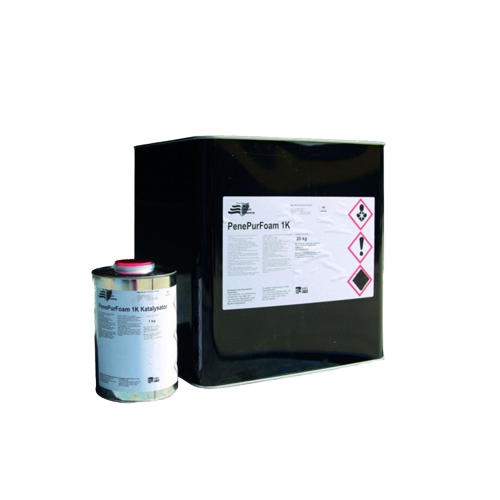
PENEPURFOM 1K
Description:
One component low viscosity hydroactive injection polyurethane resin. Upon contact with water, it foams, filling the void, forming a dense, water-resistant flexible foam with a closed fine mesh structure.
Destination:
- Stopping pressure leakage through building structures;
- sealing of mobile and static cracks with an opening of more than 0.15 mm;
- Filling of deformed joints before installation of PeneBand/PeneBandS systems. Advantages:
- Active reaction with water to form elastic foam;
- The material is one-component, ready for use;
- Ability to speed up polymerization time using a catalyst.
Features:
- Resistance to sea water;
- Contains no solvents and freon;
- Resin reaction products are resistant to acids, alkalis and microorganisms.
Technical characteristics:
|
The name of the indicator |
PenePurFom 1K |
PenePurFom 1K Catalyst |
Test methodology |
|
Shelf life of the mixture of resin and catalyst without contact with water and air humidity*, not less than 20±2 °С |
48 |
GOST 27271 |
|
|
Density, kg/m3 |
1000 ± 50 |
1000 ± 50 |
GOST 18329 |
|
Dynamic viscosity at a certain temperature*: 5°С, Pa-s 25°С, Pa-s |
3.0 ± 0.5 0.7 ± 0.1 |
0.06 ± 0.01 0.02 ± 0.01 |
GOST 10587 |
|
Increase in resin volume at 20±2 °C during interaction, not more than %: - with catalyst and water - with water |
1300 800 |
- |
ТУ 5775-009779198312013 |
PENEPURFOM 1K INSTRUCTIONS FOR USE
Perform the work at a surface temperature of the structure between +5 and +35 °C.
Safety rules:
It is necessary to use personal protective equipment during work: rubber gloves resistant to chemicals, cotton gloves, respirator, goggles, overalls made of dense fabric, rubber boots. If resin comes into contact with skin or eyes, rinse immediately with water and seek medical attention.
Surface cleaning:
Using a pump or high-pressure water jet,
wash the seam gap, cracks with water.
Preparing the pump:
After mixing the resin with the catalyst, use the "EK-100M" hand pump or the "EK-200" electric pump. Before using the resin, perform a test flush of the pump with hydraulic oil (eg Mobn HLP-68 or equivalent) in circulation mode.
Installation of injectors:
Usually, metal injectors with ball valves are used. The diameter of the holes should be 1-2 mm larger than the diameter of the injector (for example, if the diameter of the injector is 10 mm, the diameter of the hole should be 11-12 mm).
- Drill injection holes at an angle of ~ 45° to the surface. The distance between holes and recesses from the edge of the crack, concreting joints should be in the thickness of the structure;
- Clean the holes with compressed air and install the last injector;
- Prevent the leakage of resin on vertical and upper surfaces, for this purpose make a strip of 25x25 mm along the edge of the crack and fill it with "Scrape M500 Repair" solution mixture. The temperature of the resin should be at least +17°C. As the temperature decreases, the viscosity increases, and as the temperature increases, the life of the pot decreases.
- Select the amount of catalyst based on the water filtration rate and the ambient temperature (see table);
- To prepare a control batch to evaluate the viability of the resin under the conditions of the facility;
- Prepare the amount of resin that can be used during the lifetime of the boiler: mix the resin with the catalyst for 3 minutes, by hand or with a low-speed drill (up to 300 rpm).
|
Amount of catalyst,% |
Reaction time with water depending on temperature |
|||
|
+ 5°С |
+ 15°С |
+ 25°С |
+ 30°С |
|
|
0 |
60 min |
40 min |
30 min |
20 min |
|
1 |
11 min |
8 min |
7 min |
6 min |
|
2 |
8 min |
7 min |
6 min |
5 min |
|
3 |
7 min |
6 min |
5 min |
4 min |
|
4 |
6 min |
5 min |
4 min |
3 min |
|
5 |
4 min |
3 min |
2 min |
1 min |
Injection works are carried out by sequential injection of resin into vertical cracks from the bottom to the top.
- The injection is carried out until the pressure rises or until the resin begins to flow from the next hole;
- Install the next injector and continue the injection process;
- When the viscosity of the resin increases, wash the pump with a solvent (for example, solvent 646 GOST 18188) and prepare a new part of the resin;
- After the main injection, before the start of its polymerization, carry out an additional injection into the injectors already filled with resin;
- If the injectors need to be removed, fill the hole cavity with Penekrit solution mixture.
Cleaning the pump:
Flush the pump and hoses first with solvent (eg xylene or solvent 646 GOST 18188) and then with hydraulic oil (eg Mobil HLP-68 or its equivalent). Remove the dried resin mechanically.
